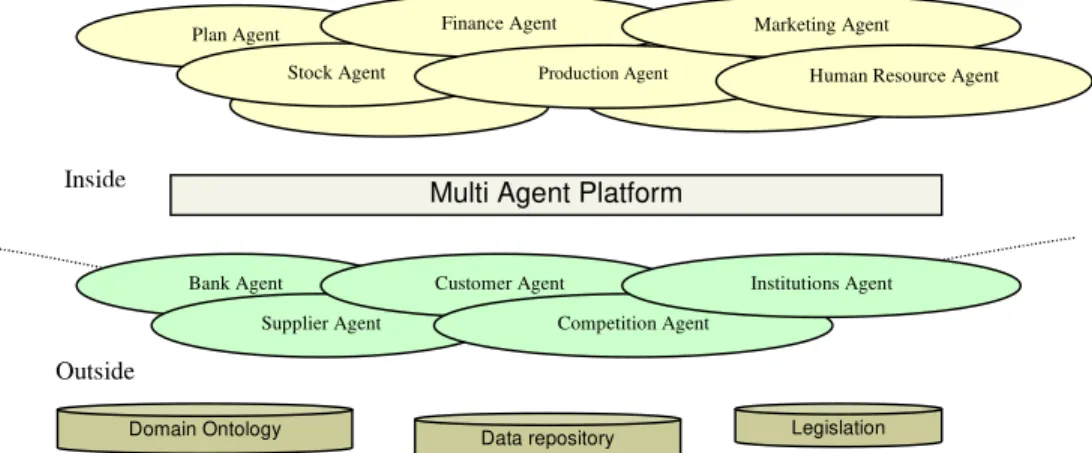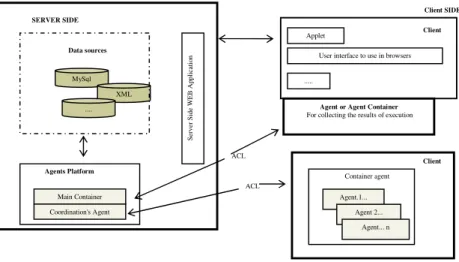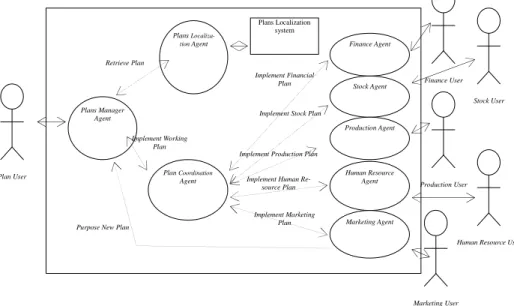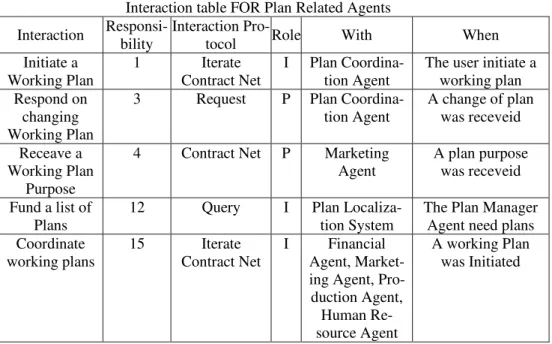ANALYSIS AND DESIGN FOR AN WORKING PLAN
COORDINATION USING JADE MULTI-AGENT SYSTEM
IN DECISION MAKING PROCES
Perşa Eugen Claudiu, Perşa Dana
Universitatea de Vest “Vasile Goldiş” Arad, Filiala Satu Mare,persa@uvvgsm.ro
Abstract
Systems composed of interacting autonomous agents offer new ways in developing applica-tions in complex domains. Using a multi-agent platform to coordinate an information sys-tem is an appropriate choice because of the complexity and dynamism required. Data flux of an economical system is generally built to follow document movements. On the other hand, decision making and disseminating processes are complex and must be flexible and network distributed. Our goal is to build a Decision Support System (DSS) using JADE Multi-agent system. This paper reflects a small part of this goal so we are emphasizing the working plan coordination.
Keywords: Agent based system, information system, decision suport systems, working plan, coordination, JADE
Introduction
A Decision Support System provides useful information to the user which in turn helps them to obtain or to make decisions. Normally anagent’s system struc-ture follows the organizational scheme of the firm. On the inside, agent strucstruc-ture is usually represented by different aspects of firm management types and on the
out-side is represented by interface agents of firm environment.
Figure 1 Multi-Agent system organization
Domain Ontology
Multi Agent Platform
Plan Agent
Stock Agent
Finance Agent
Production Agent
Marketing Agent
Human Resource Agent
Bank Agent
Supplier Agent
Customer Agent
Competition Agent
Institutions Agent
Data repository Legislation
Inside
Figure 2. The agent’s communication method
A Decision Support System (DSS) is an interactive software-based system intended to help decision makers compile useful information from a combination of raw data, documents, personal knowledge, or business models to identify and solve problems and make decisions (Shim J.P. et all, 2002). There are several types of DSS:
• communication-driven DSS – supports more than one person working on a shared task
• data-driven DSS or data-oriented DSS– emphasizes access to and manipulation of a time series of internal company data and, sometimes, external data
• document-driven DSS– manages, retrieves, and manipulates unstructured infor-mation in a variety of electronic formats
• knowledge-driven DSS– provides specialized problem-solving expertise stored as facts, rules, procedures, or in similar structures
• model-driven DSS– emphasizes access to and manipulation of a statistical, fi-nancial, optimization, or simulation model
A DSS build using a MAS can combine these DSS approaches in a very flexible and dynamic way.
In references (Collinsa J. at all, 2007, Pardoe D., Stone P., 2006) it was developed a multi-agent system for supply chain management in planning and co-ordination of activities from procurement to production and distribution of goods. That agent based architecture is built to simulate a supply chain management and
it’s a good start in analyzing agent’s behavior. Others (Urbani D., Delhom M., 2008) use a Hybrid MAS GIS as DSS.
1. Interactions between Preexistent Applications and Multi-Agent platform
SERVER SIDE
Client SIDE
MySql
XML
....
Data sources
Agents Platform
Main Container
Coordination's Agent
S
e
rv
e
r
S
id
e
W
E
B
A
p
p
li
c
at
io
n
Client
Applet
User interface to use in browsers
...
Client
Container agent
Agent.1...
Agent 2...
Agent... n ACL
ACL
Agent or Agent Container
A MAS is usually built over a preexistent information system and it must reuse that previous data.
Currently, the classic application has two sides: the client side and the server side. Our approach for the client side includes the possibility to utilize agent
containers that can migrate on client’s system (network or on a single computer), do
their own job and communicate with the main container by the Agent-communication method (usually ACL messages). For the preexistent applet or other client-side application it is necessary to have one agent that converts the result of computation for these applications. For example the problem of daily funds circula-tion of the firm including cash and bank funds. We can use a preexisting applicacircula-tion and an agent can pick-up the results, include them in the ACL messages and pass
them to the server’s main container to populate the data source with the new data, or a new agent can deal with the fund circulation. If we implemented that kind of agent
it can be conceived with an “intelligent behavior” e.g.it can pay the most important
bills without human support, he can have a “strategy” for “saving money” and so on.
For the Server Side this Agents Platform has the main role in our architec-ture, which has four types of agent sets:
1. One set of agents which have the capability to access and analyses data from dif-fered data sources. Here we can implement several agents for data mining and finding patterns, relevant result or thematic result. For example “how is the stock
of materials affected by the financial crisis?”
2. One set of agents to coordinate and capture important results for preexisting non-agents server side application.
3. One set of agents for outside the firm. These agents collect the necessary infor-mation for example: from stock market, from governmental institutions, or about consumer polices.
4. One set of agents for decision support. These agents can assist the managers in their decisions, or can make their own decision.
The agents can be heterogeneous, they can have social behavior and they can also dynamically leave and enter in the system.
2. Choosing the Organizational Structure
The choice of the organizational structure is a very critical phase in MAS development, affecting all subsequent phases. Unfortunately, as is always the case with architectural design, it is not possible to identify a precise and formal
method-ology with which to obtain the “best” design. Nevertheless, a design methodmethod-ology
could and should give guidelines to help the designer make choices.
3. Agent descriptions
At the beginning we will analyze the most important agents for decision support because all MAS were built around them. A functional enterprise generally has a well organize decision structure. Below we describe the main agents which have a GUI to support a human interaction.
A. PlanningAgent
It’san important agent and its role is to ensure the maximization of profit or
sales and the firm’s survival. The agent’s survival is achieved if the performance of
the firm is satisfactory and satisfies the various interest groups in the firm, including the owners. This agent coordinates the other agents and through a plan can dynami-cally change others agents goals.
Figure 3 Decision-making process.
B. Finance Agent
Finance is the science of funds management. The Finance Agent role is to control financial flux of firm funds (and maybe the assets). This role is accom-plished through the interaction with otheragents, the management of the firm’s a s-sets and the planning of an optimal monetary flux. A finance agent analyzes firm income (sales revenue, bank interest etc.) and expenses (raw materials, inventory, salary, transport and other costs, overdraft and late delivery penalties) and tries to optimize payments. In collaboration with Stock Agent, finance agent tries to iden-tify which RFQ to issue to which supplier.
C. MarketingAgent
His role is to analyze and react toward the market opportunities and deter-mine what products or services may be of interest to customers, the strategy used in sale as well as communications and business development (Kotler, P. et all., 2008). Besideit’s participation in the working plan there are some important roles of the Marketing Agent which need to be underlined:
•Market analyzes.It’s important to observe and measure the economical firm env i-ronment to see business opportunities and evade the pitfalls. But all of this must be well quantified. A good idea (to help automate the decision system) is to man-age trust quantification for all the persons or institutions the firm has contact. •Purpose New Plan– Marketing Agent can analyze outside firm environment and
observing marketing movements intervene and purpose some plan modification according not only Marketing Plan but other plans also to Plan Manager Agent.
Set higher objective
Set lower objective
Set objective Evaluate performance
Objective Achieved? No
D. Stock Agent
Stock Agent analyzes the firm stocks and tries to optimize products storage and movements. His input data is from warehouses and operates with component inventory reports and product inventory reports; deliveries from suppliers and pro-duction consume according to propro-duction schedule; finished products, deliveries to customers according to delivery schedule.
E. Human Resource Agent
Human’sResource Agent’s basic goal is to divide the work into reasonably manageable units. To do this we must take in consideration the following aspects: division of labor and specialization, responsibility and authority, chain of command and span of control (Dhillon B. S., 2002).
F. ProductiontAgent
Production Agent coordinates manufacturing goods according to the Pro-duction Plan. This agent use and modify preexisted proPro-duction graphics and try to optimize production. His actions are closely related to Stock Agent and Human Re-source Agent.
G. Bank Agent, Customer Agent, Institutions Agent, Supplier Agent, Competitor Agent
These agents contain knowledge about the outside world and offer a way to interact with these partners.
I. Methodology Overview
According to (Nikraz M., Caire G., Bahri P., 2006) a methodology serves as a guide for the system designer when developing a system. The methodology de-scribed consists of four stages: planning, analysis, design and implementation with a move back and forth between analysis and design steps. The concepts behind the methodology try to conduct at the end of the design phase to a straight progress to the implementation.
2. System Planning
In this part we try to answer some simple questions. The first and most im-portant one is:
-Is a multi-agent platform implementation the best way to solve the problem? As with any methodology, some assumptions must be made. These include: • Using agents is assumed.
• The JADE platform is the platform of choice for implementation.
3. System Analysis
The analysis phase aims to clarify the problem without any (or minimal) con-cerns about the solution. The methodology used was described in the cited literature (Nikraz M., Caire G., Bahri P., 2006).
A. Use Cases
a graphical notation (as an alternative, it is also possible to produce written use cases). Though use cases are used extensively by object-oriented practitioners, their applicability is not restricted to object oriented systems, because they are not object orientated in nature. Hence, it is also possible to apply use cases (without modifica-tion) to capture the functional requirements of multi-agent systems.
B. Responsibilities Identification and Acquaintances Identification
I choose to cumulate two steps (Responsibilities Identification and Ac-quaintances Identification) described in literature (Wooldrige M., Jennings N., Kinny D., 2000).
In these steps, for each identified agent type, an initial list is made of its main responsibilities in an informal and intuitive way. The artifact resulting from this process is the responsibility table. Acquaintance models simply define the communication links that exist between agent types. They do not define what mes-sages are sent or when mesmes-sages are sent— they simply indicate that communica-tion pathways exist (Wooldrige M., Jennings N., Kinny D., 2000). Note that no dis-tinction is made between acquaintances and responsibilities, so that all acquaintan-ces are placed in the responsibility table and not separated. By applying the above rules to the plan managing case study, the consideration of the managing agents is initiated and Table 1 is produced. As an observation, in this paper we focus on plan
managing and other agent’s responsibilities are not (or are partially) covered. Figure 4 Agent diagram methodology for Plan Managing
Marketing User Plans Manager
Agent
Plans Localization system
Plans Localiza-tion Agent
Retrieve Plan
PlanCoordination Agent Implement Working
Plan
Finance Agent
Stock Agent
Production Agent
Human Resource Agent Implement Financial
Plan
Implement Stock Plan
Implement Production Plan
Implement Human Re-source Plan Plan User
Finance User
Stock User
Production User
Human Resource User Marketing Agent
Purpose New Plan
Tab. 1. Responsibilities table for Plan Related Agents
Agent type Responsibilities
Plan Agent 1. Serve requests from Plan User to initiate Working Plans. 2. Let the Plan User to insert or modify plans.
3. Respond to Plan Coordination Agent request on exchange Working Plan 4. Receave an Marketing’s Agent Plan Purpose
5. Present Plans to Plan Coordination Agent.
6. Present (to the user) incoming Working Plans from Marketing Agent. 7. Let the user accept an incoming Working Plan.
8. Let the user reject an incoming Working Plan. 9. Let the Plan User to modify Working Plan Purpose. Plan
Localizatio n Agent
10.Provide Working Plans to Plan Agent 11.Receave an New Working Plan
12.Use Plans Localization system to localize Working Plans Plan
Coordinati on Agent
13.Receave an Working Plan from Plan Agent
14.Provide particular plans to Financial Agent, Marketing Agent, Production Agent, Human Resource Agent
15.Coordinate Financial Agent, Marketing Agent, Production Agent, and Human Resource Agent in achieving their plans.
16.Inform Plan Agent about acceptance of Working Plan 17.Inform Plan Agent about a plan step succes
18.Inform Plan Agent about a plan step failure Finance
Agent
19.Negociate Financial Plan from Plan Coordination Agent 20.Serve requests from Finance User to manage firms finance.
21.Present (to the user) incoming Financial Plan from Plan Coordination Agent. 22.Let the user accept an incoming Financial Plan.
23.Let the user reject an incoming Financial Plan.
24.Coordinate Bank Agent, Customer Agent, Institutions Agent, Supplier Agent acoording financial isues.
25.Inform Plan Coordination Agent about a plan step succes 26.Inform Plan Coordination Agent about a plan step failure Marketing
Agent
27.Negociate Marketing Plan from Plan Coordination Agent
28.Present (to the user) incoming Marketing Plan from Plan Coordination Agent. 29.Let the user accept an incoming Marketing Plan.
30.Let the user reject an incoming Marketing Plan. 31.Build a trust database about all bussines participants 32.Elaborate a proposal for a New Working Plan 33.Present (to the user) New Working Plan 34.Let the user accept an New Working Plan. 35.Let the user reject an New Working Plan.
36.Inform Plan Coordination Agent about a plan step succes 37.Inform Plan Coordination Agent about a plan step failure 38.Serve requests from Maketing User to manage trusts. 39.Elaborate a Trust Modify List
40.Let the user accept an Trust Modify List 41.Let the user reject an Trust Modify List. 42.Let the user modify an Trust Modify List. 43.Save the Trust Modify List
Production Agent
44.Negociate Production Plan from Plan Coordination Agent
45.Present (to the user) incoming Production Plan from Plan Coordination Agent. 46.Let the user accept an incoming Production Plan.
48.Inform Plan Coordination Agent about a plan step succes 49.Inform Plan Coordination Agent about a plan step failure Human
Resource Agent
50.Negociate Human Resouce Plan from Plan Coordination Agent
51.Serve requests from Human Resource User to manage human Resources.. 52.Present (to the user) incoming Human Resource Plan from Plan Coordination Agent.
53.Let the user accept an incoming Human Resource Plan. 54.Let the user reject an incoming Human Resource Plan 55.Inform Plan Coordination Agent about a plan step succes 56.Inform Plan Coordination Agent about a plan step failure.
Source: Own processing
C. Agent Refinement
In this step the agent’s diagram and responsibility table are updated by ap-plying a number of considerations related to support, discovery, and management and monitoring. These considerations are about:
•How agents acquire data from system? In this case there are three ways to get data from system. Rewriting the code, using a data wrapper or creating a transducer agent who serves as an interface between a legacy system and the other agents in the system. We choose the most general (but also the slowest) implementation and use transducer agents.
•How one agent discovers other agents? There are two ways: first through agent name and second by using a Yellow Page Agent. The last one is recommended in a multi agent system and is our choice.
4. Design
From this point on, the proposed methodology focuses on the JADE plat-form (and hence, the constructs provided by it), it may not be suitable for direct ap-plication to other multi-agent development platforms. The design phase will allow us to reach a level of detail that is enough to have a relatively straightforward transi-tion to the implementatransi-tion, with the possibility of a significant amount of code be-ing generated by an automatic tool.
A. Interactions Specification
In this stage we build an interaction table for each agent type witch is a ta-ble row in the tata-ble will represent an interaction. JADE implement interaction pro-tocol roles as behaviors. JADE MessageTemplate objects are specified to be used in these behaviors to receive incoming messages, and these templates appear at Tem-plate columns on the interaction table.
Table 2 contains the following columns: •Interactions– describe a interaction
•Responsibility– a link between interaction and responsibilities tables •Interaction Protocol– preferable a FIPA or user defined protocol
•Role– the role of agent in interaction protocol (I– Initiator, P– participant) •With– other agents who are involve in protocol
5. Future Work
This paper describes only a fraction of a DSS but an important one. We will continue this work analyzing other aspects of DSS and of course with the imple-mentation step.
6. Conclusion
Multi-Agent Systems is a valid option in building a Decision Support Sys-tem especially with the growth of the Internet. A well structured DSS built on MAS adds significant flexibility, interactivity and intelligent behavior to any company or institution, it can easily be implemented on an already existent information system and can easily substitute human behavior in making operative decisions.
Tab. 2 Interaction table FOR Plan Related Agents
Interaction Responsi-bility
Interaction
Pro-tocol Role With When
Initiate a Working Plan
1 Iterate
Contract Net
I Plan Coordina-tion Agent
The user initiate a working plan Respond on
changing Working Plan
3 Request P Plan
Coordina-tion Agent
A change of plan was receveid
Receave a Working Plan
Purpose
4 Contract Net P Marketing Agent
A plan purpose was receveid
Fund a list of Plans
12 Query I Plan
Localiza-tion System
The Plan Manager Agent need plans Coordinate
working plans
15 Iterate
Contract Net
I Financial Agent, Market-ing Agent, Pro-duction Agent, Human Re-source Agent
A working Plan was Initiated
Source: Own processing
References
Collinsa J. Arunachalam R., Sadeh N., Eriksson J., Finne N., Janson S., 2007, The Supply Chain Management Game for the 2007 Trading Agent Competi-tion, Technical Report CMU-ISRI-07-100, Carnegie Mellon University;
Dhillon B. S., 2002, Engineering and Technology Management Tools and Applications, Artech House Inc.;
Kotler P., Gary A.., Veronica W., John S., 2008, Marketing Defined, Prin-ciples of Marketing (5th ed.), Prentice Hall Europe;
Nikraz M., Caire G., Bahri P., 2006, A Methodology for the Analysis and Design of Multi-Agent Systems using JADE, International Journal of Computer Systems Science & Engineering;
Pardoe D., Stone P., 2006, Predictive Planning for Supply Chain Manage-ment, in Proceedings of the Sixteenth International Conference on Automated Planning and Scheduling (Cumbria, UK). ICAPS-06;
Shim J. P., Warkentin M., Courtney J. F., Power D. J., Sharda R., Carlsson C., 2002, Past, Present, and Future of Decision Support Technology, Decision Support Systems 33;
Signorile R., 2005, A Decision Support System for Inventory Control Us-ing PlannUs-ing and Distributetd Agents, SprUs-inger-Verlag Berlin Heidelberg;
Urbani D., Delhom M., 2008, Analyzing Knowledge Exchanges in Hybrid MAS GIS Decision Support Systems, Toward a New DSS Architecture, Springer-Verlag Berlin Heidelberg;
Uschold M., King M., Moralee S., Zorgios Y., 1997, The Enterprise Ontol-ogy, AIAI, The University of Edinburgh;
Wooldrige M., Jennings N., Kinny D., 2000, The Gaia Methodology for Agent Orinted Analysis and Design, Journal of Autonomus Agents and Multi-Agent System3;
Zambonelli F., Jennings R. N., Wooldridge M., 2003, Developing Multi-agent Systems: The Gaia Methodology, ACM Transactions on Software Engineer-ing and Methodology, Vol. 12, No. 3;





